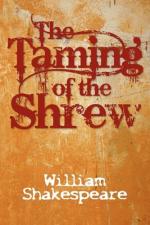|
This section contains 479 words (approx. 2 pages at 400 words per page) |

|
The Taming of the Shrew Summary & Study Guide Description
The Taming of the Shrew Summary & Study Guide includes comprehensive information and analysis to help you understand the book. This study guide contains the following sections:
This detailed literature summary also contains Further Study on The Taming of the Shrew by William Shakespeare.
Shakespeare is thought to have written The Taming of the Shrew between 1590 and 1594, although the only version that has survived is the one published in the First Folio in 1623. It appears to have been staged several times during Shakespeare's lifetime at both the Globe and the Blackfriars theaters, and a sequel written by John Fletcher between 1604 and 1617 attests to its popularity. It was also produced in 1633 at the court of Charles I.
The play has a complex structure. It begins with a two-scene "Induction" or introductory segment, which concerns an elaborate practical joke played by a nobleman on a drunken tinker. At the end of the Induction the various characters settle down to watch a play. This "play within a play," which in turn consists of a main plot and a complex subplot, constitutes the main action of The Taming of the Shrew.
Shakespeare appears to have drawn on many sources in writing the play. The character of the "shrew"-a word used to indicate an opinionated, domineering, and sharp-tongued woman-is found in the folklore and literature of many cultures. The earliest example in English drama is thought to be the character of Noah's wife in the medieval mystery plays. In the sixteenth century shrewish wives were featured in a number of plays, many of which depicted cruel physical punishments for the shrew. The principal source of the Bianca-Lucentio subplot is George Gascoigne's play Supposes (1566). Gascoigne's play was itself de rived from an Italian play, Ludovico Ariosto's I Suppositi (1509), and many of its elements can be traced back to the classical Latin comedies of Plautus and Terence. As for the Induction, the story of a poor man tricked into thinking he is a nobleman was common in Europe and Asia in the sixteenth century, and is at least as old as the story of the Caliph Haroun AI Raschid and the beggar Abu Hassan in The Arabian Nights. In addition, an anonymous play entitled The Taming of a Shrew and published in 1594 is generally thought to be either a pirated copy of Shakespeare's play or an inaccurate copy of an earlier play that may have been another source for Shakespeare's version. While the action of The Taming of a Shrew is very close to that of Shakespeare's play, both the language and the names of the characters are different. One interesting difference between the two plays concerns the Induction. In Shakespeare's playas we have it, the characters in the Induction are not mentioned in the text after the end of Act I, scene i. In A Shrew, on the other hand, the story line of the Induction is brought to a conclusion at the end of the play. Some modern productions of Shakespeare's Shrew incorporate material from The Taming of a Shrew in order to complete the story introduced in the Induction. Others eliminate the Induction altogether.
Read more from the Study Guide
|
This section contains 479 words (approx. 2 pages at 400 words per page) |

|



